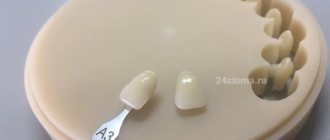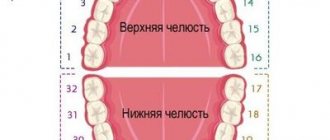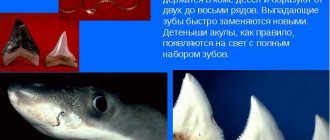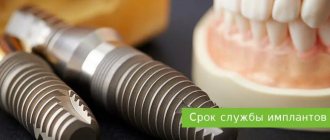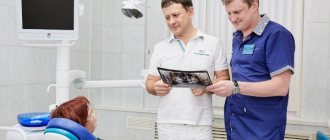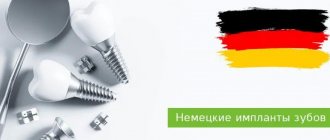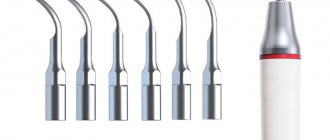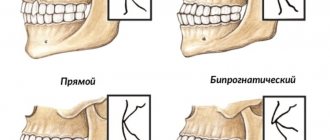Polyodontia is an abnormal number of teeth.
In medicine, this disease is often called hyperdontia, and “extra” dental elements are called supernumerary teeth. Research is still being conducted into why this pathology occurs. Most scientists associate it with disturbances in the formation of tooth germs.
Nature provides that a person grows no more than 20 milk teeth and 32 permanent teeth in a lifetime, but exceptions occur, and in our time quite often. According to statistics, on average, dental anomalies occur in 2% of the world's population, most often in men.
In 2014 alone, two operations were performed, in one of which 80 teeth were removed, and in the other, a record 232 teeth. Until this time, the maximum figure was 37 teeth.
The most common hyperdontia (anomaly in the number of teeth) is an anomaly of the upper incisors. Supernumerary teeth are less common among the lower incisors and in other parts of the jaw. They can come in a wide variety of shapes and sizes. These are usually small, cone-shaped teeth.
Extra teeth lead to deformation of the dentition, so it is recommended to remove supernumerary elements. Another reason for removal is that most patients with this pathology have a lisp.
The formation of extra teeth is quite common today. According to statistics, 70% of patients have only one extra incisor, in 25% of cases – 2 supernumerary elements, and only 5% of all patients have 3 or more teeth during examination.
Numbering of teeth in dentistry
Today, there is probably no person who has not resorted to the services of a dentist at least once. Already in the dental chair, patients often hear quite surprising things. For example, the dentist may inform them about the need to remove tooth No. 35 or treat tooth 47. For many people, such a number of teeth in their mouth is puzzling, since everyone knows that a person's mouth should have a maximum of 32 teeth.
No less interesting is a visit to the pediatric dentist. When a doctor tells parents that the child’s 22nd tooth is loose and 43 is affected by caries, the reaction to such information is also quite emotional. Parents are trying to understand why their baby has more teeth than an adult.
However, there are no oddities, much less pathologies, here. The fact is that in dentistry there is a special numbering for identifying teeth. Its use makes it possible to simplify the recording of dental formulas and make the dentist’s work easier.
Serial numbers of teeth
First of all, it is worth remembering that the dentition is as symmetrical as the human face. That is, the jaw consists of two halves - right and left. The jaws are also divided into upper and lower. The first thing you need to remember is the serial number of teeth with the same functions.
1. Incisors or front teeth. Required for biting food. They have sharp edges and are flat in shape. The number of incisors is 8. Four are located on the lower jaw and four on the upper jaw. The pair of central incisors is assigned the number “1”. For example, when talking about the first lower right tooth, we mean the incisor on the bottom row on the right. Behind the first ones are the second incisors, which accordingly have the serial number “2”.
2. Fangs. Needed for tearing off pieces of food. Fangs are powerful, cone-shaped teeth. They are located behind the front incisors. Their serial number is “3”.
3. Chewing teeth. Once food enters the oral cavity, it must be experienced. This is the function that the chewing teeth perform. They are located immediately behind the fangs and are designated by two serial numbers - “4” and “5”.
4. Molars or large chewing teeth. All other teeth are in the mouth. On the surface of each molar there are tubercles that are designed for crushing and grinding food. The molars received the following serial numbers - “6”, “7”, “8”.
Jaw segments
To become more familiar with the numbering of teeth, you need to divide (visually) the jaw into 4 segments. You must start counting clockwise from the top right row.
Thus, the teeth located in the top row on the right side will be called tenths. And the teeth that are in the top row on the left are called twenties. On the bottom row, the thirties and forties, respectively.
When a serial number is added to this numbering, the tooth gets its own number. For example, when a dentist reports the need to treat the 26th tooth, this means that the patient has a problem with the first chewing tooth, which is located on the upper jaw on the left side.
Numbering in pediatric dentistry
Milk teeth are numbered slightly differently compared to the numbering of molars. To correctly understand how a child’s teeth are counted, you should turn to anatomy. In children, baby teeth begin to appear at about six months of age. At the same time, the formation of permanent teeth occurs. With a long-term absence of a baby tooth, the other two, which are located on both sides, begin to move closer together. As a result, there will no longer be room for the permanent tooth to grow. This will cause it to move out of line and overlap other teeth.
If you take an X-ray of the jaw of a five-year-old child, you can see both baby teeth and molars. In this case, the molars are numbered from 11 to 48. The primary teeth are identified by the following tens. When milk teeth are replaced by molars, the greatest activity of tooth growth is observed. Thus, the numbering of teeth in pediatric dentistry is as follows:
— top row on the right — 51-55;
— top row on the left — 61-65;
— bottom row on the right — 71-75;
- bottom row on the left - 81-85.
Since children have only 20 primary teeth, the numbering ends at the 5th tooth.
Thus, having familiarized yourself with the peculiarities of tooth numbering, you will no longer be surprised that you have problems, for example, with the 47th tooth.
Causes of polyodontia
Medicine has not yet found an exact answer to the question of what are the causes of supernumerary teeth. Scientists put forward several hypotheses:
- Atavism. Supernumerary teeth are explained by the fact that the dental system strives to return to the original number of elements laid down by nature. There is evidence that our ancestors had 6 incisors on both the lower and upper jaws. As a result, many doctors consider atavism to be the cause of the development of polyodontia in humans.
- Splitting of the tooth germ. Even in the embryonic period, the activity of the dental plate is disrupted in the child, as a result of which hyperdontia is formed. Violations can be caused by viruses, poor ecology, drugs, medications prohibited during pregnancy, alcohol and other factors. This hypothesis is increasingly supported today, because recently the disease has been rapidly progressing due to bad habits and poor ecology.
The causes of hyperdontia continue to be researched. Scientists cannot give an exact explanation for this anomaly, but most of them are inclined to the second hypothesis - the splitting of the tooth germ at the embryonic stage.
What does polyodontia look like?
Quite often, extra teeth are almost indistinguishable from normal ones. It is not uncommon for them to grow in the form of a drop or a thorn. These dental elements can appear either individually or fused with permanent ones. They can form tooth-like formations and entire arrays of teeth.
Also in medical practice, there are cases where polyodontia was hidden and was detected only by radiography. There are many different cases of abnormal development of the number of teeth, and if you notice symptoms, you should definitely contact the dentist.
Types of polyodontia disease
Polyodontia in the oral cavity manifests itself in different ways. By studying the statistics, signs and symptoms of the disease, dentists were able to classify the types of this anomaly.
Depending on the origin, the disease is divided into two types:
- False polyodontia. Provides for a baby tooth that does not fall out, regardless of the person’s age. At the same time, it fulfills its functions, does not create discomfort to the bite, and is firmly fixed in the patient’s jaw. In addition, teeth fused together and other anomalies are classified as a false type of disease.
- True polyodontia. It can be caused by genetic predisposition, as well as terogenic factors. At the same time, extra molars begin to form in the human jaw.
As for the placement of extra teeth, dentists distinguish the following types of disease:
- Typical hyperdontia. Applies to those patients in whom extra teeth appear only in the dentition and do not extend beyond it. Many scientists are confident that this is simply heredity, because our ancestors had a more developed dental system than modern people.
- Atypical hyperdontia. It occurs much less frequently and is characterized by the appearance of teeth outside the dentition.
In case of anomalies with baby teeth, the latter pose almost no threat. On the contrary, such a tooth can last a lifetime. But the permanent molars, over which the supernumeraries grow, should be removed, if only because it is not aesthetically pleasing.
Often, the patient grows extra fangs or incisors, or even several front teeth at once. In addition to a ruined smile, the disease can cause serious complications if the necessary measures are not taken in time.
Molars - normal or abnormal?
Speaking of molars! Why do some have them and others don't? And why is both their absence and their presence considered the norm?
The study of the evolution of molars shows that they are facing imminent extinction - complete disappearance from the human mouth. Once upon a time, the human jaw could accommodate as many as 44 teeth, today there are 32, but a tendency towards reduction is observed, which is due to soft food. A few hundred years and molars can completely disappear. Some modern people never have them!
It turns out, from the point of view of modern dentistry, the number of teeth in a person’s mouth from 28 to 32 is considered the norm. If you have a full set of teeth (32), we congratulate you on reaching the norm. But in practice, only a select few reach the standard of a complete set!
Symptoms of the disease in children
The first supernumerary teeth in children appear before birth or in the first six months of life. The main inconvenience they cause is difficulty in feeding.
Polyodontia of primary teeth in older children occurs with symptoms similar to the eruption of regular teeth. In this case it is observed:
- temperature increase;
- swelling of the gums in the place where the tooth should erupt;
- pain;
- excessive salivation;
- swelling of the nasal mucosa;
- loose stool.
Symptoms are especially severe when extra teeth appear in the upper palate.
If hyperdontia makes itself felt in a two-year-old child, this can interfere with the formation of normal speech. In turn, due to injury to the tongue and mucous membranes, some kind of inflammation constantly appears in the oral cavity.
When supernumerary teeth appear in very noticeable places in school-age children, ridicule towards the patient may occur, which is fraught with the development of psychological problems and complexes in the future.
Orthodontic treatment after extraction
Since the presence of supernumerary teeth for a long time has a negative impact on the normal eruption of complete teeth, it is advisable to combine their removal with subsequent orthodontic treatment. This is justified by the fact that complete teeth, having received additional space, may take an incorrect position when independently moved to the extraction zone. In such cases, the device is made before the tooth extraction surgery, but the installation of the device occurs on average 1 week - after the hole has healed and the bone tissue has been restored. This allows you to immediately begin gently moving teeth on the thinnest arch using braces.
Removing any tooth, including a supernumerary one, can cause a child quite severe psychological discomfort. That is why pediatric dentists at our Center pay great attention to the emotional state of pediatric patients. The use of certain psychological tactics allows you to cope with childhood fears and form a positive attitude towards medicine. The complete absence of unpleasant sensations during the procedure creates confidence in the dentist.
Symptoms of hyperdontia in adults
Polyodontia affects permanent teeth more often than baby teeth. An adult usually develops dystopic and impacted supernumerary teeth.
Dystopic teeth are those that appear outside the dental arch. Most often they erupt on the lingual surface of the gums and in the palate. With this form of the disease, the patient typically:
- poor pronunciation of sounds;
- noticeable malocclusion;
- change in the usual arrangement of teeth: curvature of the angle at which they grow, as well as their rotation
- around its axis;
- frequent injury to the oral mucosa and, as a result, its inflammation;
- disruption of chewing processes, resulting in digestive problems.
Among other things, dystopic teeth often cause psychological problems. Due to a non-aesthetic, and sometimes completely unattractive smile, the patient becomes withdrawn and uncommunicative. Psychological problems, in turn, cause chronic diseases of the endocrine, digestive and nervous systems.
Impacted supernumerary teeth are teeth that do not erupt, but continue to remain in the bone tissue of the human jaw. Often they hardly make themselves felt until complications begin. Dentists diagnose this anomaly during a routine examination of the patient.
This abnormality in the number of teeth is accompanied by the following symptoms:
- normal teeth begin to loosen (the condition is considered pathological);
- the bone begins to protrude (if the impacted tooth is too close to the edge of the jaw);
- Aching pains appear periodically.
One of the most difficult situations is when extra teeth grow in place of impacted third molars. Wisdom teeth cannot grow and begin to negatively affect the roots of other teeth, which in turn can lead to serious complications.
Which animal has 28 teeth? Why do some people only have 28 teeth?
Any medical reference book contains information about a person having 32 teeth.
Of these, eight are incisors, four canines and 20 large and small molars. This is considered normal for an adult aged 25 years and older. Dental consultant Nadezhda Alekseeva explains that a person’s adult row of permanent teeth is formed by the age of sixteen. But at this time there are only 28 of them. Four molars, the so-called wisdom teeth, grow only by the age of twenty-five. However, not all. According to statistics, 25 percent of the world's population has no wisdom teeth at all. This is how they live with 28 teeth.
Logically, those with an incomplete set of teeth should feel uncomfortable. But this doesn't happen. There are no inconveniences. Sixteen molars instead of twenty do an excellent job of chewing food. Nadezhda Alekseeva explains that such a number of teeth may be due to genetic predisposition, dietary habits, or be an evolutionary development. The first reason is more or less clear. But the second and third are closely related.
Anthropologists have found that our distant ancestors had 44 teeth. This was necessary, since a person ate raw food, as a result of eating it, he often had to tear it with his teeth, especially if it was meat. But as a result of evolution, when meat and other products began to be subjected to heat treatment and food became much softer, the number of teeth in humans began to decrease, reaching 32. And now the number 28 no longer bothers anyone. Dentist, surgeon, orthopedist Sultan Gadzhiev explains that in 80 percent of cases, wisdom teeth are sure to appear in people who eat a lot of raw vegetables and fruits. Also, according to the doctor, all four third molars (the medical name for this type of molar) usually erupt in residents of the southern regions. This is facilitated by the high content of vitamin D in the body, which the sun generously supplies it with.
Scientists say: due to the fact that people's food is becoming more and more soft, a person's jaw row will continue to thin out. Nature cannot tolerate useless elements and gets rid of them in the process of evolution.
In the USA they approach this issue differently. American dentist Jerome Lawrence explains: just some two hundred years ago, the average human life expectancy did not exceed 45-50 years. By this time, even if people’s teeth were falling out, not all of them were falling out. Now a person lives almost twice as long. And by the age of 70, he loses most of his teeth. Implants do not take root in everyone, but if they take root, a person is not always able to use them freely. And the wisdom teeth, which appear last, become the anchors on which the foundations of the artificial jaw are then attached.
For Russia, this is all the more important since not every pensioner can afford even one implant, let alone a larger number.
Nadezhda Alekseeva talks about a new trend when, at the slightest inconvenience that the appearance of wisdom teeth brings, people try to get rid of them. If the tooth grows normally, you just need to wait out the unpleasant sensations and under no circumstances remove it. In old age, these teeth can be very helpful, the dentist is sure.
However, if the wisdom tooth grows incorrectly, is initially curved, and its appearance puts pressure on the jaw, as a result of which it begins to undergo deformation, it must be urgently removed. The same should be done with a crooked wisdom tooth, even if it does not cause any inconvenience. It is very difficult to clean, and no matter how hard you try, it is almost impossible to completely get rid of plaque and germs. This means that this tooth will become a source of spread of putrefactive bacteria and caries.
Consequences of polyodontia disease
Polyodontia in humans can often be the cause of retention. This is a phenomenon in which normal teeth are unable to erupt due to the interference of supernumerary teeth. The former may remain in the jaw or take an abnormal position.
In addition, even if the complete incisor grows before the supernumerary one, the latter will be able to displace it. This will lead to the person being unable to chew food normally. And if several extra incisors grow at once, they can cause the loss of permanent teeth.
Diagnostics
Examining supernumerary teeth during an x-ray is not as easy as it seems. They can be superimposed along the contour onto the permanent ones and remain invisible. In such cases, patients are recommended to undergo a computed tomography scan, which shows a more accurate picture of the disease.
If the extra dental elements have already erupted, the dentist can easily detect them. In practice, the patients themselves find the erupted supernumerary teeth and already at the initial appointment with the dentist they complain about the pathology.
When should supernumerary teeth be removed?
Reasons for removal may vary: from aesthetics to obvious damage to the health of the main dentition. Therefore, it makes sense to remove excess teeth if:
- There is a risk of losing a permanent healthy tooth.
- Retention of normal dental units is possible.
- Supernumerary teeth are carious or affected by other pathologies.
- Polyodontia distorts the normal dentition and spoils the smile with its unaesthetic shape and location in the mouth.
- Due to the growth of abnormal teeth, bite and diction are impaired, and the mucous membrane is injured.
- Threat of resorption of permanent row roots.
- The germ of an extra tooth produced a cystic formation.
When supernumerary teeth are “not conspicuous”, do not cause discomfort, and do not harm the normal dentition, then, in principle, they can be left alone. But still, in order to finally make a decision, careful studies using X-rays and computed tomography are needed, as well as consultation with an experienced specialist, so as not to miss any hidden problems from this dental pathology.
Symptom relief
Most often, in adults, extra teeth erupt without any symptoms, but for children this can become a problem that needs to be addressed.
Supernumerary teeth erupt with the same symptoms as regular teeth, so the treatment for them is the same.
- To lower the temperature, it is recommended to give your baby Paracetamol or Ibuprofen. If the child is very small, these drugs can be used in the form of suspensions or rectal suppositories. In addition to lowering the temperature, these medications do an excellent job of treating pain and inflammation.
- To relieve gum pain, local anesthetics are used - ointments and gels (for example, Kalgel, Dentinox, Solokoseryl). These remedies cope well with painful sensations and slightly relieve inflammation.
- Adults and children over 2 years of age can be treated with folk remedies: propolis, honey, decoctions of calendula, chamomile and lemon balm. Some decoctions help reduce pain and relieve inflammation. Traditional methods of treatment should be used only after consultation with your doctor.
- If primary supernumerary teeth have partially erupted, stimulation of eruption is prescribed. For this purpose, vibration and electrical stimulation, as well as special massage, are used.
Normal deletion
If the dentist decides that in a particular case, polyodontia can only be treated by removing an extra tooth, the patient should count on the following procedures:
- First of all, the patient should be sent for radiography. This is necessary in order to determine the size and number of roots, as well as the ratio of supernumerary and normal teeth.
- After collecting research, the doctor gives the patient anesthesia and removes excess teeth.
- In some cases, soft tissue sutures may be necessary after surgery.
Why is it difficult to calculate the exact number of teeth?
Dental X-ray allows you to find out the exact number of teeth.
How many teeth do you have? This question may also seem simple: now let’s calculate and find out! But a surprise may await you. After all, the number of roots and canals may differ due to the fact that the latter very often bifurcate near the pulp.
It also happens that several canals are located in parallel in one root and only an x-ray will help you calculate the exact number of teeth in your mouth!
To accurately count everything in a tooth, dentists at YuliSTOM clinics use x-rays. This allows you to avoid incidents during dental treatment!
Removal of impacted teeth
In order for the operation to be successful and polyodontia to be cured without any complications, the doctor must fully examine the patient and plan his further actions.
- To begin with, X-rays and/or computed tomography are performed to determine the exact topography of the anomaly.
- Removal is performed under local anesthesia, but there are cases when general anesthesia can be used on the patient.
- First, the mucous membrane is peeled off, then the bone tissue is opened and the root and crown parts of the tooth are removed.
- If necessary, bone defects are covered with osteoplastic material, and the mucous membrane is sutured.
After tooth extraction, the patient continues treatment at home: takes antibiotics (if prescribed by the attending physician), rinses the oral cavity with antiseptic solutions.
Until the wound heals after surgery, it is not recommended to eat too hot, hard or spicy food. You should also brush your teeth carefully, especially on the operated side.
